2018 HONDA CLARITY PLUG IN HYBRID towing
[x] Cancel search: towingPage 6 of 591
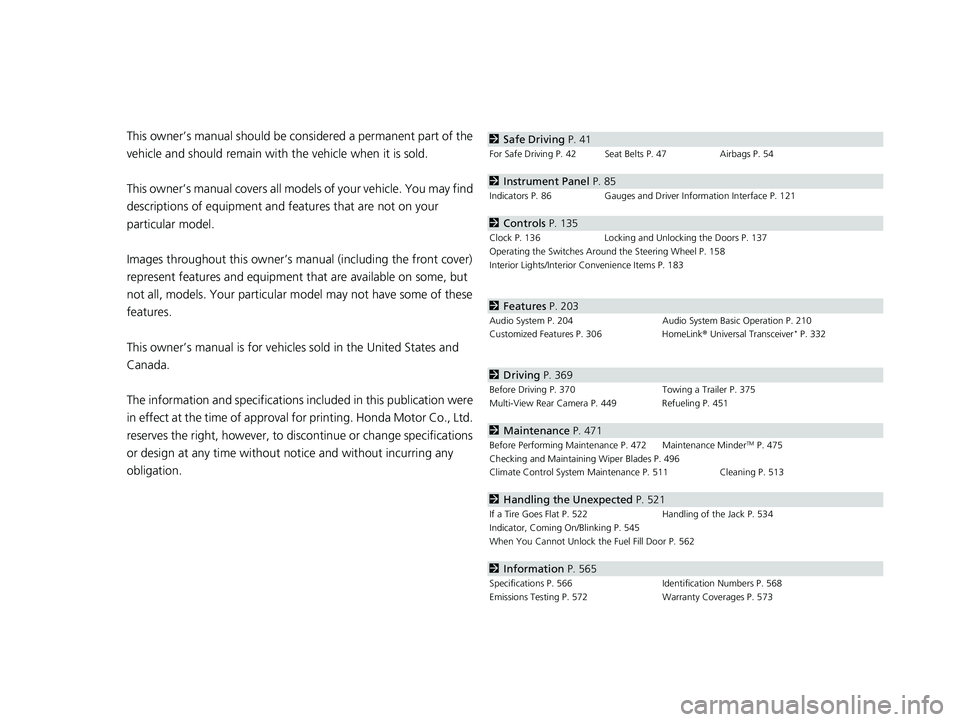
Contents
This owner’s manual should be co nsidered a permanent part of the
vehicle and should remain with the vehicle when it is sold.
This owner’s manual covers all models of your vehicle. You may find
descriptions of equipment and features that are not on your
particular model.
Images throughout this owner’s manu al (including the front cover)
represent features and equipment that are available on some, but
not all, models. Your particular mo del may not have some of these
features.
This owner’s manual is for vehicles sold in the United States and
Canada.
The information and specifications in cluded in this publication were
in effect at the time of approval for printing. Honda Motor Co., Ltd.
reserves the right, however, to discontinue or change specifications
or design at any time without notice and without incurring any
obligation. 2 Safe Driving P. 41For Safe Driving P. 42 Seat Belts P. 47 Airbags P. 54
2 Instrument Panel P. 85Indicators P. 86 Gauges and Driver Information Interface P. 121
2 Controls P. 135 Clock P. 136 Locking and Unlocking the Doors P. 137
Operating the Switches Ar ound the Steering Wheel P. 158
Interior Lights/Interior Convenience Items P. 183
2 Features P. 203 Audio System P. 204 Audio System Basic Operation P. 210
Customized Features P. 306 HomeLink ® Universal Transceiver *
P. 332
2 Driving P. 369 Before Driving P. 370 Towing a Trailer P. 375
Multi-View Rear Camera P. 449 Refueling P. 451
2 Maintenance P. 471Before Performing Maintenance P. 472 Maintenance Minder TM
P. 475
Checking and Maintaining Wiper Blades P. 496
Climate Control System Main tenance P. 511 Cleaning P. 513
2 Handling the Unexpected P. 521If a Tire Goes Flat P. 522 Handling of the Jack P. 534
Indicator, Coming On/Blinking P. 545
When You Cannot Unlock the Fuel Fill Door P. 562
2 Information P. 565Specifications P. 566 Identi fication Numbers P. 568
Emissions Testing P. 572 Warranty Coverages P. 57318 CLARITY PHEV CSS-31TRW6000.book 6 ページ 2017年8月31日 木曜日 午後2時4 9分
Page 7 of 591
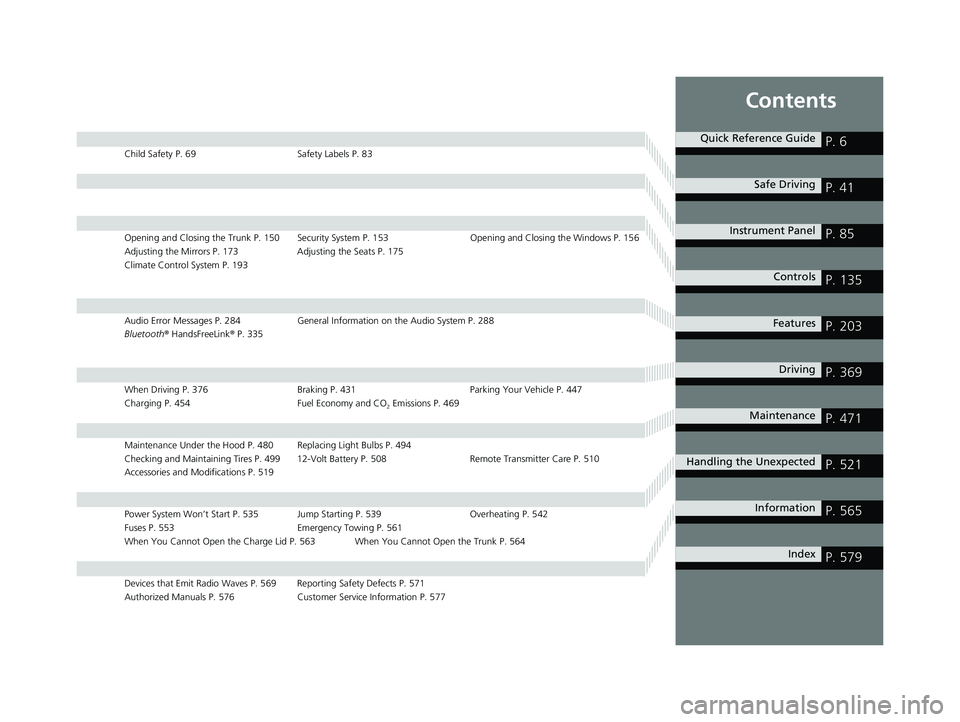
ContentsChild Safety P. 69 Safety Labels P. 83
Opening and Closing the Trunk P. 150 Security System P. 153 Opening and Closing the Windows P. 156
Adjusting the Mirrors P. 173 Adjusting the Seats P. 175
Climate Control System P. 193
Audio Error Messages P. 284 General Information on the Audio System P. 288
Bluetooth ® HandsFreeLink ® P. 335
When Driving P. 376 Braking P. 431 Parking Your Vehicle P. 447
Charging P. 454 Fuel Economy and CO 2
Emissions P. 469
Maintenance Under the Hood P. 480 Replacing Light Bulbs P. 494
Checking and Maintaining Tires P. 499 12-Volt Battery P. 508 Remote Transmitter Care P. 510
Accessories and Modifications P. 519
Power System Won’t Start P. 535 Jump Starting P. 539 Overheating P. 542
Fuses P. 553 Emergency Towing P. 561
When You Cannot Open the Charge Lid P. 563 When You Cannot Open the Trunk P. 564
Devices that Emit Radio Waves P. 569 Reporting Safety Defects P. 571
Authorized Manuals P. 576 Customer Service Information P. 577 Quick Reference Guide
P. 6 Safe Driving
P. 41 Instrument Panel
P. 85 Controls
P. 135 Features
P. 203 Driving
P. 369 Maintenance
P. 471 Handling the Unexpected
P. 521 Information
P. 565
Index
P. 57918 CLARITY PHEV CSS-31TRW6000.book 7 ページ 2017年8月31日 木曜日 午後2時4 9分
Page 38 of 591
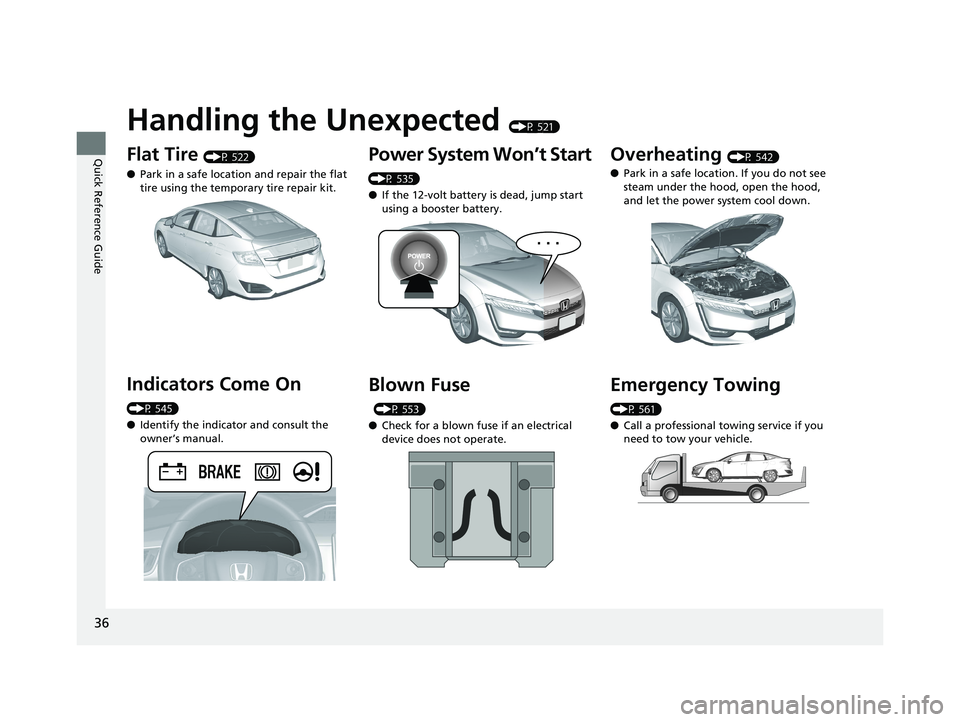
36
Quick Reference Guide Handling the Unexpected (P 521)
Flat Tire (P 522)
● Park in a safe location and repair the flat
tire using the temporary tire repair kit.
Indicators Come On (P 545)
● Identify the indicator and consult the
owner’s manual. Power System Won’t Start (P 535)
● If the 12-volt battery is dead, jump start
using a booster battery.
Blown Fuse
(P 553)
● Check for a blown fuse if an electrical
device does not operate.Overheating (P 542)
● Park in a safe location. If you do not see
steam under the hood, open the hood,
and let the power system cool down.
Emergency Towing (P 561)
● Call a professional towing service if you
need to tow your vehicle.18 CLARITY PHEV CSS-31TRW6000.book 36 ページ 2017年8月31日 木曜日 午後2時 49分
Page 371 of 591

369Driving This chapter discusses driving and refueling.
Before Driving ................................... 370
Towing a Trailer ................................ 375
When Driving
Turning on the Power ...................... 376
Precautions While Driving................. 380
Transmission .................................... 381
Shifting ............................................ 382
ECON Mode .................................... 388
SPORT Mode.................................... 389
Deceleration Paddle Selector ............ 390
Acoustic Vehicle Al erting System ...... 393
Front Sensor Camera ....................... 394
Road Departure Mi tigation (RDM)
System ........................................ 396 Adaptive Cruise Control (ACC) with Low
Speed Follow (LSF) ......................... 400
Lane Keeping Assist System (LKAS) .. 415
Vehicle Stability Assist (VSA ® ), aka
Electronic Stability Control (ESC),
System ....................................... 422 Agile Handling Assist ....................... 424
Tire Pressure Monitoring System (TPMS) .. 425
Tire Pressure Monitoring System (TPMS) -
Required Federal Explanation ......... 427
LaneWatch TM
................................... 429
Braking .............................................. 431
Parking Your Vehicle
When Stopped................................. 447 Multi-View Rear Camera .................. 449
Refueling
Fuel Information .............................. 451
How to Refuel ................................. 452
Charging
Before Charging .............................. 454
Charge the High Voltage battery using a
Level 1 or 2 charger ....................... 455
Control Box ..................................... 461
High Voltage Battery........................ 466
Using a Timer .................................. 467
Fuel Economy and CO 2
Emissions
Improving Fuel Economy and Reducing
CO 2
Emissions ................................ 46918 CLARITY PHEV CSS-31TRW6000.book 369 ページ 2017年8月31日 木曜日 午後2時49分
Page 375 of 591
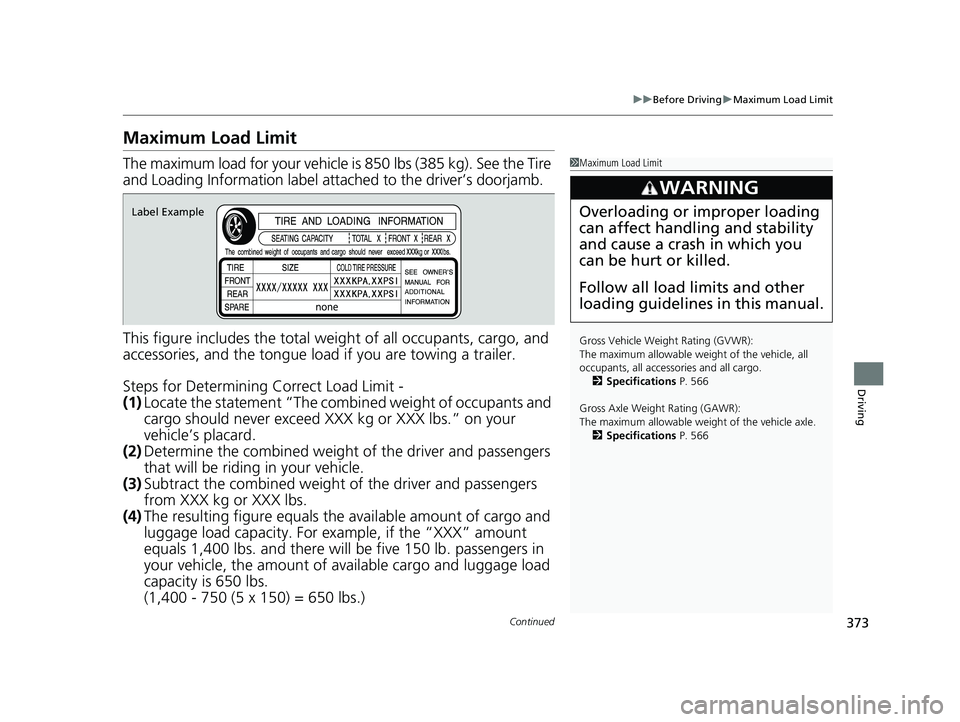
373uu Before Driving u Maximum Load Limit
Continued
Driving
Maximum Load Limit The maximum load for your vehicle is 850 lbs (385 kg). See the Tire
and Loading Information label atta ched to the driver’s doorjamb.
This figure includes the total weig ht of all occupants, cargo, and
accessories, and the tongue load if you are towing a trailer.
Steps for Determining Correct Load Limit -
(1) Locate the statement “The comb ined weight of occupants and
cargo should never exceed XXX kg or XXX lbs.” on your
vehicle’s placard.
(2) Determine the combined weight of the driver and passengers
that will be riding in your vehicle.
(3) Subtract the combined weight of the driver and passengers
from XXX kg or XXX lbs.
(4) The resulting figure equals the available amount of cargo and
luggage load capaci ty. For example, if the “XXX” amount
equals 1,400 lbs. and there will be five 150 lb. passengers in
your vehicle, the am ount of available cargo and luggage load
capacity is 650 lbs.
(1,400 - 750 (5 x 150) = 650 lbs.) 1 Maximum Load Limit
Gross Vehicle Weight Rating (GVWR):
The maximum allowable weight of the vehicle, all
occupants, all accesso ries and all cargo.
2 Specifications P. 566
Gross Axle Weight Rating (GAWR):
The maximum allowable weight of the vehicle axle.
2 Specifications P. 5663
WARNING Overloading or improper loading
can affect handling and stability
and cause a crash in which you
can be hurt or killed.
Follow all load limits and other
loading guidelines in this manual.Label Example18 CLARITY PHEV CSS-31TRW6000.book 373 ページ 2017年8月31日 木曜日 午後2時49分
Page 376 of 591
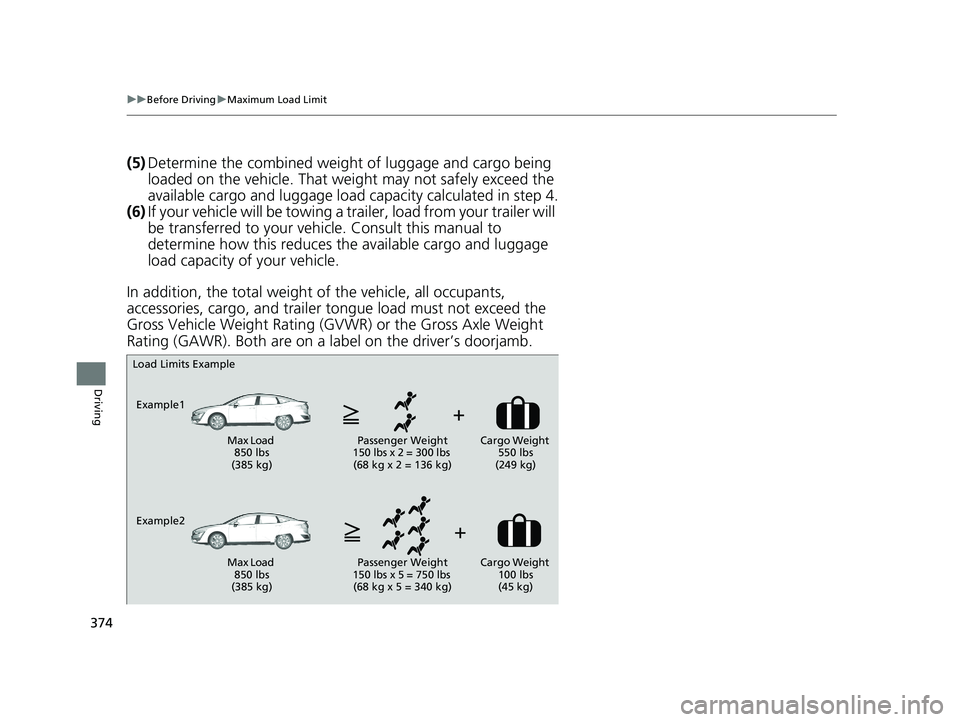
374 uu Before Driving u Maximum Load Limit
Driving (5) Determine the combined weight of luggage and cargo being
loaded on the vehicle. That we ight may not safely exceed the
available cargo and luggage load capacity calculated in step 4.
(6) If your vehicle will be towing a tra iler, load from your trailer will
be transferred to your vehicl e. Consult this manual to
determine how this reduces th e available cargo and luggage
load capacity of your vehicle.
In addition, the total weight of the vehicle, all occupants,
accessories, cargo, and trailer tongue load must not exceed the
Gross Vehicle Weight Rating (GVW R) or the Gross Axle Weight
Rating (GAWR). Both are on a label on the driver’s doorjamb. Load Limits Example
Example1
Max Load
850 lbs
(385 kg) Passenger Weight
150 lbs x 2 = 300 lbs
(68 kg x 2 = 136 kg) Cargo Weight
550 lbs
(249 kg)
Example2
Max Load
850 lbs
(385 kg) Passenger Weight
150 lbs x 5 = 750 lbs
(68 kg x 5 = 340 kg) Cargo Weight
100 lbs
(45 kg)18 CLARITY PHEV CSS-31TRW6000.book 374 ページ 2017年8月31日 木曜日 午後2時49分
Page 377 of 591
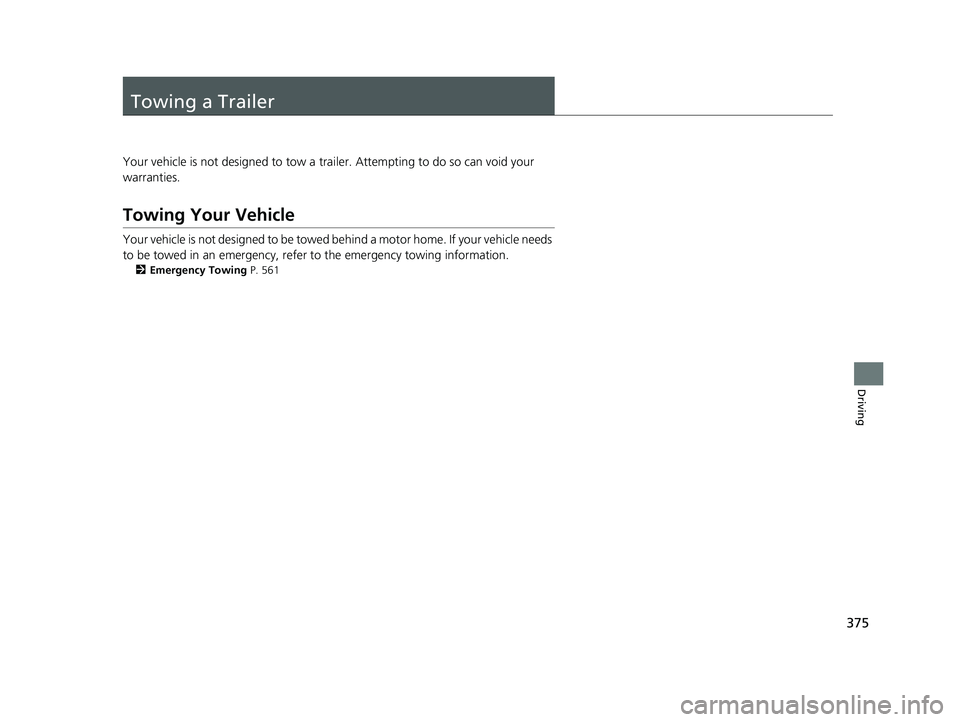
375
Driving
Towing a Trailer Your vehicle is not designed to tow a traile r. Attempting to do so can void your
warranties.
Towing Your Vehicle Your vehicle is not designed to be towed behind a motor home. If your vehicle needs
to be towed in an emergency, refer to the emergency to wing information.2 Emergency Towing P. 56118 CLARITY PHEV CSS-31TRW6000.book 375 ページ 2017年8月31日 木曜日 午後2時49分
Page 427 of 591
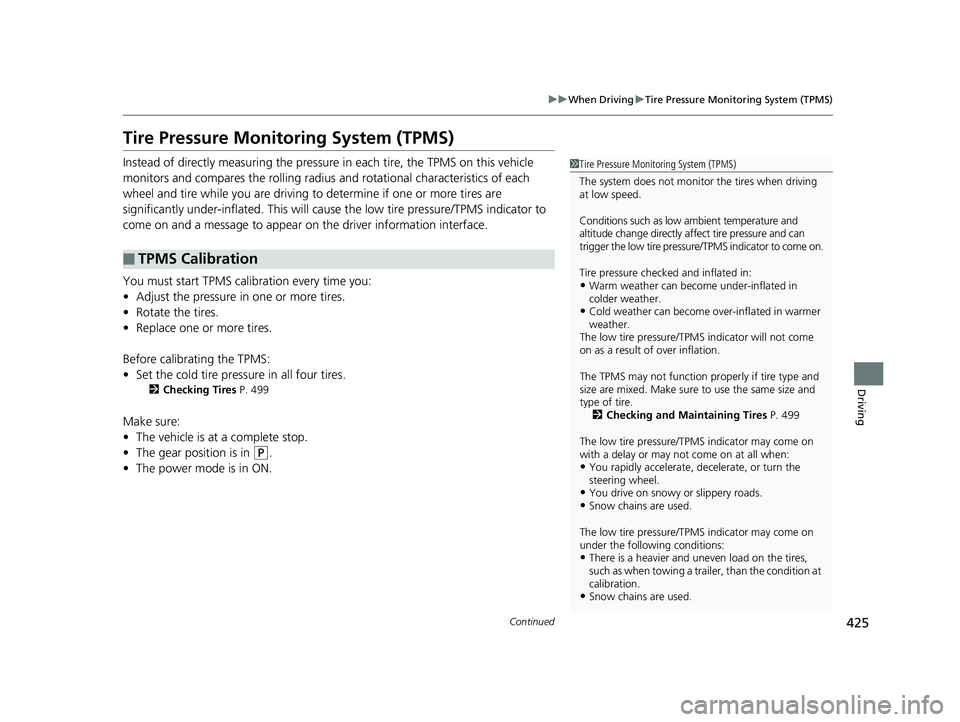
425uu When Driving u Tire Pressure Monitoring System (TPMS)
Continued
Driving
Tire Pressure Monitoring System (TPMS) Instead of directly measuring the pressure in each tire, the TPMS on this vehicle
monitors and compares the rolling radius and rotational characteristics of each
wheel and tire while you are driving to determine if one or more tires are
significantly under-inflated. This will caus e the low tire pressure/TPMS indicator to
come on and a message to appear on the driver information interface.
You must start TPMS calibration every time you:
• Adjust the pressure in one or more tires.
• Rotate the tires.
• Replace one or more tires.
Before calibrating the TPMS:
• Set the cold tire pressure in all four tires. 2 Checking Tires P. 499
Make sure:
• The vehicle is at a complete stop.
• The gear position is in ( P
.
• The power mode is in ON.■ TPMS Calibration 1 Tire Pressure Monitoring System (TPMS)
The system does not monitor the tires when driving
at low speed.
Conditions such as low ambient temperature and
altitude change directly a ffect tire pressure and can
trigger the low tire pressure/TPMS indicator to come on.
Tire pressure checked and inflated in:
• Warm weather can beco me under-inflated in
colder weather.
• Cold weather can become over-inflated in warmer
weather.
The low tire pressure/TPMS indicator will not come
on as a result of over inflation.
The TPMS may not function pr operly if tire type and
size are mixed. Make sure to use the same size and
type of tire.
2 Checking and Maintaining Tires P. 499
The low tire pressure/TPMS indicator may come on
with a delay or may not come on at all when:
• You rapidly accelerate, decelerate, or turn the
steering wheel.
• You drive on snowy or slippery roads.
• Snow chains are used.
The low tire pressure/TPMS indicator may come on
under the following conditions:
• There is a heavier and une ven load on the tires,
such as when towing a trailer, than the condition at
calibration.
• Snow chains are used.18 CLARITY PHEV CSS-31TRW6000.book 425 ページ 2017年8月31日 木曜日 午後2時49分